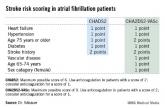Conference Coverage

CHA2DS2-VASc score performs best in assessing atrial fibrillation stroke risk
Major finding: During 5 years of prospective follow-up of patients with nonvalvular atrial fibrillation, 145 patients who had a stroke, transient...

Atrial fibrillation is not a single disease, and specialists already have ways to distinguish one type from another and guide management. But new methods are emerging to better distinguish various causes and types of atrial fibrillation, further refine management, and offer new intervention approaches.
This new way of looking at AF has been called personalized management, and while some cardiologists may quibble that a fully personalized approach to managing each AF patient is still likely a decade or more away, there seems to be wide agreement that AF patients are heterogeneous and the more that can be learned about the etiology and character of AF in each patient, the better care will be.
"Atrial fibrillation is not a disease, it is a syndrome" in which different patients "present with similar ECG patterns and complications, but with completely different causes," said Dr. Paulus Kirchhof, an organizer of the AFNET/EHRA consensus group, during a session on personalized AF at the American Heart Association’s scientific sessions last November. "We are still in the process of trying to understand the individual mechanisms [causing AF], and then we try to translate that into parameters that can be measured. Once we get there, we can probably reclassify AF as a disease with different causes in different people. But we still need more work to better classify AF based on causal mechanisms," said Dr. Kirchhof, professor of cardiovascular medicine at the University of Birmingham, England.
AF classification evolves
More than 2 decades ago, atrial fibrillation was classified as either acute or chronic. Starting about 20 years ago, classification by duration became a little more subdivided, into categories of paroxysmal, persistent, long-term persistent, and permanent. This rough taxonomy, focused on episode duration, guides some facets of management today and has "served a reasonable function, but has done as much as it could. So, we’re searching for a new taxonomy that will help us progress further, a taxonomy based on mechanisms," said Dr. A. John Camm, professor of clinical cardiology at St. George’s, University of London, and another organizer of the AFNET/EHRA group.
"The electrophysiology community and the physician community are starting to get comfortable with the current AF taxonomy of paroxysmal, persistent, and long-standing persistent. But those who spend a lot of time thinking about AF recognize that this scheme is overly simplistic and that other parameters are important," said Dr. Hugh Calkins, professor and director of the cardiac arrhythmia service at Johns Hopkins Medical Center in Baltimore. "I do not believe it is time to make a dramatic shift to a new AF taxonomy now, especially for day-to-day care, but it is likely that over time new parameters will be included when describing AF patients. The proposed new classification scheme may provide a useful framework as this research moves forward," Dr. Calkins said in an interview. Dr. Calkins, president of the U.S.-based Heart Rhythm Society, was one of the 72 coauthors of the AFNET/EHRA consensus statement and one of the few participants not based in Europe.
"Given the complexities of AF, a personalized approach is and will continue to be essential. This is widely accepted and not controversial," said Dr. Peter R. Kowey, chief of cardiovascular diseases at Main Line Health in Wynnewood, Pa. "But each new parameter used to categorize AF will require careful validation before its adoption," he said in an interview. "Subclassification of AF would be helpful, but it will need to be data driven and carefully vetted before it will be accepted," said Dr. Kowey, who was not a member of the AFNET/EHRA group.
"The concept of personalized AF management is not new and not controversial. It is at the core of optimal patient care," Dr. Calkins concurred.
"Our hope is that molecular, genomic, and novel ECG and structural-imaging modalities will guide AF treatment in the future," said Dr. Anne M. Gillis, professor of medicine at the University of Calgary (Alta.), speaking during the AHA session last November. "At present, we start with rate control and move on to rhythm control when dictated by symptoms, with ablation continuing to emerge as the primary option. In the future we think there will be a focus on prevention and a personalized approach, with a greater emphasis on rhythm control that may involve mechanism-directed ablation against foci and rotors."
Dr. Gillis, immediate past president of the Heart Rhythm Society, and some of her colleagues endorsed the concept of a personalized approach to AF management and increasing reliance on new methods to further distinguish various types of AF patients in a commentary last year (Can. J. Cardiol. 2013;29:1141-6).

Major finding: During 5 years of prospective follow-up of patients with nonvalvular atrial fibrillation, 145 patients who had a stroke, transient...
